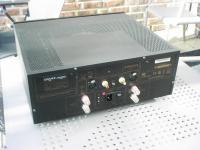Von Audio Equipment Mauritz
http://www.mauritzaudio.de
Zurück zu Neuheiten
http://www.mauritzaudio.de
Produktgruppe: Endverstärker
SE1 Mk II von NAT (Nikic Audio Team)
25.03.2011
Wir haben die Röhren- Monos von NAT in der Mk II Version für Sie vorführbereit.
MkII version already improve quality of previous model by increasing power to 30W with special driver, super tube 6N30P-DR(military grade).
Single Ended Mono Block Power Amplifier Se1 has very short signal path without passive components. It means that this circuit contains no coupling capacitors & no inter-stage transformers. Specially designed hand wounded output transformers improve frequency bandwidth, over standard construction.
Frequency response of our Mono Blocks Se 1 from 9 Hz to 60 kHz is extremely linear without any sub resonance region.
Se1 has automatic bias circuit means current trough output tube(211) is always the same. There is no need for any type of adjustment.
Sound quality is totally independent against power supply instability, because all stages in amplifier have stabilization.
These Mono Blocks require sensitively loudspeaker (over 90dB / 2.83V / 1m @ 8 ohms), but with some of the single ended \"friendly\" loudspeaker Se 1 will bring you great sonic pleasure that only real single ended triode virtues can do.
Design Features
- single ended type
- mono block concept
- absolute zero feedback with ultra low feedback option
- pure class \"A\"
- all triode configuration
- short signal path
- no coupling capacitor from input to output
- no interstage transformer
- direct heated 211 triode output tube
- absolute zero feedback or ultra low feedback option
- hand wound output transformer (custom design for NAT)
- torodial low density power transformer (custom design for NAT)
- regulated power supply for all stages
- automatic bias control for output tubes
- soft start operate to improve long term stability
- WBT output connectors
- hand assembled all aluminum modulated chassis
- 10mm thick aluminum front panel (standard black finish, optional silver)
- extensively used computer numeric control machines (CNC)
MkII version already improve quality of previous model by increasing power to 30W with special driver, super tube 6N30P-DR(military grade).
Single Ended Mono Block Power Amplifier Se1 has very short signal path without passive components. It means that this circuit contains no coupling capacitors & no inter-stage transformers. Specially designed hand wounded output transformers improve frequency bandwidth, over standard construction.
Frequency response of our Mono Blocks Se 1 from 9 Hz to 60 kHz is extremely linear without any sub resonance region.
Se1 has automatic bias circuit means current trough output tube(211) is always the same. There is no need for any type of adjustment.
Sound quality is totally independent against power supply instability, because all stages in amplifier have stabilization.
These Mono Blocks require sensitively loudspeaker (over 90dB / 2.83V / 1m @ 8 ohms), but with some of the single ended \"friendly\" loudspeaker Se 1 will bring you great sonic pleasure that only real single ended triode virtues can do.
Design Features
- single ended type
- mono block concept
- absolute zero feedback with ultra low feedback option
- pure class \"A\"
- all triode configuration
- short signal path
- no coupling capacitor from input to output
- no interstage transformer
- direct heated 211 triode output tube
- absolute zero feedback or ultra low feedback option
- hand wound output transformer (custom design for NAT)
- torodial low density power transformer (custom design for NAT)
- regulated power supply for all stages
- automatic bias control for output tubes
- soft start operate to improve long term stability
- WBT output connectors
- hand assembled all aluminum modulated chassis
- 10mm thick aluminum front panel (standard black finish, optional silver)
- extensively used computer numeric control machines (CNC)


